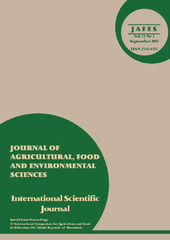Приказ основних података о документу
The effect of cover crops on the content of protein in grain of sweet maize
| dc.creator | Dolijanović, Željko | |
| dc.creator | Dragičević, Vesna | |
| dc.creator | Simić, Milena | |
| dc.creator | Oljača, Snežana | |
| dc.creator | Kovačević, Dušan | |
| dc.creator | Janošević, Biljana | |
| dc.date.accessioned | 2022-10-24T07:49:26Z | |
| dc.date.available | 2022-10-24T07:49:26Z | |
| dc.date.issued | 2018 | |
| dc.identifier.issn | 2545-4315 | |
| dc.identifier.uri | http://rik.mrizp.rs/handle/123456789/1019 | |
| dc.description.abstract | The study was conducted in the experimental field of the Maize Research Institute Zemun Polje, Serbia, during 2013/14-2014/15. The experiment was established as a block design with four replications. As winter cover crops-CC (factor A) the following plants were grown: CV–common vetch (Vicia sativa L.), FP-field pea (Pisum sativum L.), WO-winter oats, (Avena sativa L.), FK-fodder kale (Brassica oleracea (L.) convar. acephala), two mixture variants of legume crops with oats (CV+WO and FP+WO) and two control treatments: a variant in which the surface was covered with dead organic mulch (DOM) and traditional variant: after ploughing in the fall plot stayed uncovered during the winter (TV). Green biomass of the cover crops was incorporated in the soil, immediately after, half of the elementary plot was infested with bio-fertilizer (BF) - Uniker (mobilizer of nutrients) in an amount of 10 l ha-1 (factor B), which contains the strains of cellulolytic and proteolytic bacteria to support the mineralization of entered crop residues. The seeds of sweet maize ‘ZPSC 421su (FAO 400) were sown at the arrangement of 70 cm between rows and 22 cm between plants in the row (65,000 plants per ha). Preceding crop in both years was winter wheat. The kernel protein content was measured on infrared analyser. The data were processed by ANOVA. The investigated factors (CC and BF) showed significant effect on protein content in sweet maize kernel in both years. As it was expected, the greatest impact on protein content was exhibited in leguminous species grown alone, or in mixtures with oats, particularly in the dry, 2015. Small grains intercropped with legumes obtained higher values of protein content than small grain grown as monocrops. | sr |
| dc.language.iso | en | sr |
| dc.publisher | Skoplje : “Ss. Cyril and Methodius" University in Skopje, Faculty of agricultural sciences and food | sr |
| dc.rights | openAccess | sr |
| dc.rights.uri | https://creativecommons.org/licenses/by/4.0/ | |
| dc.source | 3. International symposium for agriculture and food "ISAF 2017", Ohrid, 18-20.10.2017. - Proceedings | sr |
| dc.subject | sweet maize | sr |
| dc.subject | content of protein | sr |
| dc.subject | microbiological fertilizer | sr |
| dc.title | The effect of cover crops on the content of protein in grain of sweet maize | sr |
| dc.type | conferenceObject | sr |
| dc.rights.license | BY | sr |
| dc.citation.volume | 72 | |
| dc.citation.issue | 2 | |
| dc.citation.spage | 31 | |
| dc.citation.epage | 37 | |
| dc.identifier.fulltext | http://rik.mrizp.rs/bitstream/id/4894/3..2018.pdf | |
| dc.identifier.rcub | https://hdl.handle.net/21.15107/rcub_rik_1019 | |
| dc.type.version | publishedVersion | sr |


